Among all American cities, few others can contend for the crown of the overseas foodie capital. Everything in San Francisco talks about food. And not any food, but gourmet, sustainable, organic, local food. Frisco is the perfect destination for a gastronomic tour. And for this reason, the Fancy Food Show around there is a serious thing. Even though smaller than its New York equivalent, the gastronomic event organized by the Specialty Food Association for over 60 years gathers companies from all over the world. And, even on the West Coast, Italy does its part.
Italian System
Lorenzo Ortona, the Italian general consul in San Francisco inaugurated the Italy pavilion at the Winter Fancy Food at the end of January. “I am convinced – explained the consul to “La Voce” – that the United States and California in particular understood the benefits of the Mediterranean diet. The fact that the Fancy Food Show takes place here in San Francisco is a great opportunity for Italy to show all the high-quality products that are so welcomed here. I hope that our producers will understand and take advantage of this opportunity, so that they can grow even more.”
Most of the Italian companies exhibiting at the fair had gathered under the umbrella of the Italian Trade Agency. The director of the New York office, Maurizio Forte, who has a mandate for food, while talking to “La Voce di New York”, stressed the fact that the San Francisco event allows the expositors to create a closer relation with the buyers. “San Francisco is a less competitive area than New York and therefore doing business here pays back. Moreover, we invited to the fair buyers from other areas of the United States as well, from Texas to Michigan, to offer our producers more opportunities. We spend three days all together in San Francisco and we have the chance to talk about our companies: before coming to the fair, we ask to the buyers we invite to give us a list of 20 companies they are interested in and that they would like to meet. Those are buyers that already work with Italy, some are agents of chains we would like to start working with. We also asked other American ITA offices to help us locate interesting agents in their areas.”
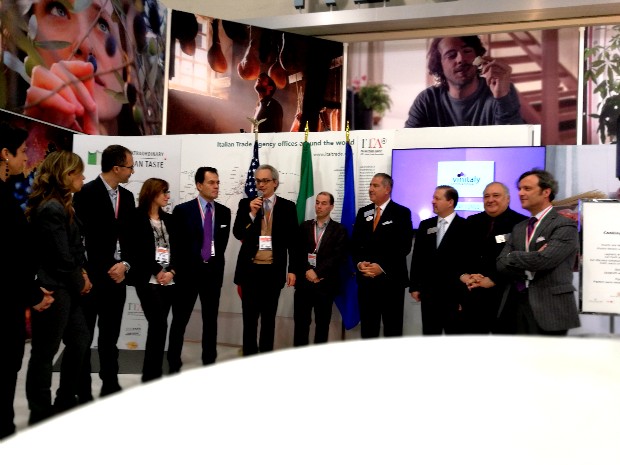
Even though 2016 wasn’t an exciting year, for the Italian export in the USA food is strategical. “The food imports from Italy to the USA grew by 2.4% in 2016 – Forte explained – but they already had grown by 10% in 2014 and 21% in 2015, therefore, a period of adjustment is normal after such a growth. 2016 was the year in which we consolidated the results of the previous years, in a scenario in which the American imports broadly shrunk: the food imports grew only by the 1% in the past year. However, Italy is the third major importer after France and India with a total exports growth by more than 1.8% towards the USA.”
The Italian Trade Agency is generally positive regarding 2017 and does not expect any surprises by the Trump presidency. “Of course, we are always worried about protectionism: it is the exact opposite of what we do. But, we hope and believe that, if any protectionist measures are taken, Italian products are not going to be at the top of the list. If anything, we are more worried about potential psychological phenomena consequent to protectionism that could lead to hard to get rid of mechanisms of replacement. Again, however, I don’t think that the kind of products we import in the US are perceived as a threat to the American market.”
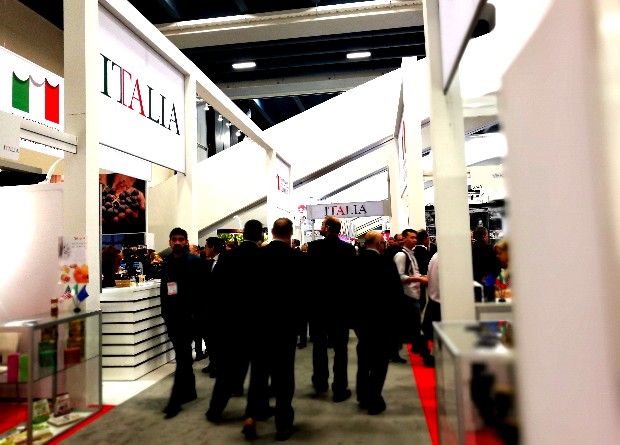
The Italian pavilion, the biggest among the national pavilions at the Winter Fancy Food, gathered 62 companies and was coordinated, as always, by Universal Marketing. The president, Donato Cinelli, explained that “compared to the New York Fancy Food, where there are more than 300 companies in the Italian pavilion, this fair is much smaller. The presence of Italian companies is also limited by the space available, otherwise, there would be many more of them. However, this limitation is also an advantage, because the exhibitors can establish a more direct relation with the visitors and also because a kind of natural selection is created: all the Italian companies here in San Francisco are high level companies, that produce high-quality products. And they still have growth opportunities.”
The Great Classics
Among the stands at the Italian pavilion there are all the classics of the genuine Italian cuisine, from pasta and oil to coffee and cheese.

Skipping the appetizer and going directly to the entrée, we had a chat with Tony and Anthony Di Rado, the US representatives of Cocco pasta, among others, from Fara San Martino, Abruzzo. Also from Abruzzo, the Di Rados are father and son; the former has always worked with the pasta factories of Fara San Martino and with Cocco for over 20 years. He talks about the company as if it was his own family business: “Giuseppe Cocco retrieved old pasta machines that were out of production. And those machines, that make a particular kind of pasta, are still used today. It is a slow process that produces very high quality pasta.”
The Di Rados followed the entire journey of this product for connoisseurs. Anthony Di Rado explained that “we don’t aim for the large distribution, but we target more the specialty food stores, as we do in Italy. We collaborate a lot with restaurants because the chef recognizes the quality of the product right away: the pasta speaks for itself.” Even though the Cocco brand looked at the American markets ever since its creation, according to the Di Rados, there is still a lot to do in order to “educate” the average American consumer on the high-quality Italian products.
Recently, the Cocco family launched a new coffee business with the brand Officina 5. “One day, one of the Coccos brothers decided that he was interested in coffee: he started to research and to look for the best products, because the Coccos, when they do something, they make it high-quality.” And the Di Rado father and son are pioneers in America even in this new adventure, teaching about this new coffee on this side of the Atlantic.
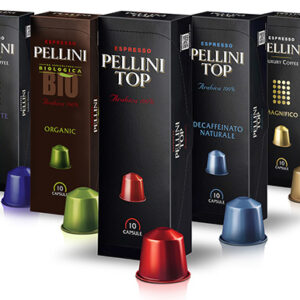
Coffee has always been, or at least since 1922, the Pellini family’s business, in Verona. The brand is the forth brand of coffee found in the houses of Italians and, in the last five years, grew a lot in Europe as well. Today, it appears on the American market with enthusiasm, but also with due precautions. “We are in a phase of market analysis – Giacomo Cinelli tells us, the export manager of the company – and we are looking for the best strategies to employ for our products. Ours is a high end, premium placement, and we are researching the perfect packaging for the American market. We have a strong brand and an excellent quality, we are sure to have all the necessary elements to conquest a place in this market.” We expect to find them soon on the shelves of the East and West coast’s stores.
Tuscany Is Ready
We all know the great made-in-Italy products, however, along with the classics, at the Winter Fancy Food, other companies represented our gastronomy, that, even following tradition, approach this market with new and bold ideas. This is the case of Mi Garba, a company form Prato that offers the authentic recipes of the Tuscan cuisine in a ready-to-heat-and-eat format and a young and captivating packaging. When Mi Garba decided to enter the American market, the company, that was founded in 1985 in Italy under the name of Tuscan Gastronomy and at the end of the 90s created a line of ready-made products, took the matter seriously. The Tempestini family, in fact, created a special brand for the USA, they decided to manage themselves the imports, distribution and commerce and they open a logistical location in Staten Island and a wine bar in the very center of Manhattan, in Union Square. At the Fancy Food, Emanuale Tempestini told us that “the fact that we wanted to get everything done ourselves is the cross we bear and our delight at the same time. It’s our cross, because we can’t be constantly present on the territory, a delight because the relationship with the customers is immediate and we can explain really well our products to them.”

The New York wine bar is crucial to the company’s image, because it is a window for Mi Garba’s products, but a lot more as well: the young atmosphere fits with the area, all the pieces of furniture were imported directly from Tuscany, all the carefully selected wines on the menu are categorically Tuscan wines. Chianti and Montalcino’s reds accompany the same dishes that the company sells in boxes. But above all, the wine bar is a way for this still new brand to get to know and interpret the public’s taste: “In the wine bar we listen to our clients and we have the chance to explain that what we now sell in boxes was made eight days ago in Tuscany. Everyone is so shocked of the fact that they are boxed products. We are faithful to our recipes, but at the same time we welcome suggestions from the American market, without cheating on traditions.” Mi Garba is entering the American large-scale retail trade and it can be found already on the East Coast, in Chicago and in Texas, where all lovers of Tuscan cuisine can taste grandma’s risotto, barley soup or ribollita directly at their homes, even though grandma stayed in Italy.
The Oil Challenge
If it is almost impossible that someone would be able to compete against Tuscans on the ribollita, there are many Italian products that find valid competitors in California. Specifically, we are talking about olive oil, a product that has seen a strong and aggressive growth of the products made in California in the past few years. However, Italians are not afraid of the competitors and have already established a historical presence on this side of the ocean.
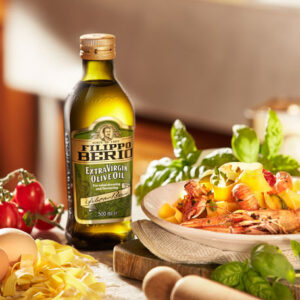
In 2017, Berio celebrates the 150th anniversary of its brand and it’s undiscussed leader in the US providing for 14% of the olive oil in the market. Marco de Ceglie, the company’s CEO for North America, knows what he wants when we are talking about the local competitors: I believe that we don’t have to be antagonists, but we need to work together to let the market grow. In the USA, the average consumption of olive oil is still very low and if it grows there would be room for everyone. California produces around 14,000 tons of olive oil per year, while the oil imports to the United States amount to 300,000 tons.” And if the American press often tried to discredit the Italian olive oil, according to de Ceglie the labels and the regulations are the best attorneys for our product: “The majority of our oils are blends, because we work on a concept of quality that goes beyond the concept of origin: there can be great and bad oils from everywhere, geography doesn’t make high quality olive oil, people do. We base our oils on a flavor profile that we know customers like and we can reproduce it every year thanks to our blends. But this happens in complete transparency and, clearly, we can’t write ‘made in Italy’ on our products, because, even though the oils are mixed in our facilities in Italy, the international custom regulation allows a country to assign the origin to the products only if a ‘substantial transformation’ occurs to the product in that country. In the case of the extra virgin olive oil, it does not happen: we cannot say that a blend of e.v.o. oil was transformed.”
If the presence of Italian oil in the US today is so strong to constitute a “threat” to the national production, it is because of the pioneer work of brave companies that came to this market when the Italian cuisine was still considered an ethnic trait. Among those companies, we can find Colavita, a brand that created its business in America, with a typically Italian character. “The company was founded by my grandfather, in Molise – told us Paolo Colavita, vice president of the company in California and part of the company’s new generation – and it is still managed by my family. Initially, it was an olive by-product factory, a microscopic reality. Then, the kids got involved, my father and my uncle. In the 70s, my father started to go around with a briefcase to meet potential customers, even abroad. One of the markets that interested him the most was exactly the United States, where the Mediterranean diet was unheard of, at the time.”

Enrico, the father, jumped in to complete the story: “My father sent me to Florence to study, but he wanted me to go back home. I accepted at the condition that he would first send me abroad to learn languages. So, I went to London and a desire to travel the world grew in me. I proposed to my father to create a line of product to sell abroad. At the time, coming to America with food products was debasing, people would tell you the market was in Italy, not there. But they never convinced me, I came to America as my honeymoon and, through one of my wife’s cousins, I met John Profaci. We liked each other, so we started to work together and we still do today.”
Today, after 40 years, Colavita is among the top brands in America and owns a factory in Edison, New Jersey, that works as a warehouse, a national distribution center, and a production line for the food service. And they are looking to the future, as Paolo Colavita told us: “Now, we are opening a new factory here on the West Coast as well, to use as a distribution center and in which we will move all our Californian oil production, too expensive to keep on producing on the East Coast.”
There, the competition against the Californian oil will be even: olives, territory, regulations and standards are the same. But even on the imported products the Colavitas fight against disinformation: “Everything started with a New York Times article based on an Italian report. Ever since then, articles never stopped to defame an entire category. We are involved in the promotion of the education on those topics and in our company everything happens with the full transparency: in Italy, there are daily inspections at customs and the European Union is very rigid on labels. In the USA, it is not required to indicate the origin of a product, but we do. We visit at least once a year all our producers wherever they are in the world, we ask them to continuously send us samples that we analyze before we buy their products and, when the oil arrives, before blending it, we analyze it again to make sure it’s the same as the samples.”
Portofino in the Bottle
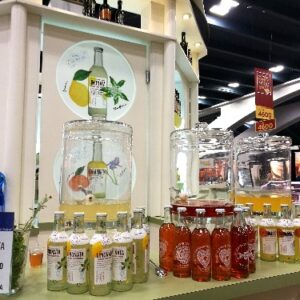
Today, Colavita is more than just oil, in fact the company also works as an importer for other brands, both small and big ones, helping the distribution of Italian-made products in the US. Among the new entries, there is a young and dynamic company that offers drinks made with 100% Italian products and the Ligurian riviera scents. With a captivating packaging that looks back at the tradition, Niasca Portofino bottles lemonades, tangerine-based drinks, and refreshing bitters that are perfect mixers for cocktails. The company, whose products can already be found at Eataly, was founded three years ago: “We bought some land on the hills surrounding Portofino – Simona Mussini, one of the founders, tells us – and we grow all the products we use to create our drinks there. The Portofino brand is a great marketing tool.”
Granma’s Cookies
If it’s true that for some companies the place makes the brand, authenticity is not always a matter of geography. There are many products that were born out of the Italian tradition even though 100% American. And for the many Italian sounding products that use the Italian character as a bait, there are as many that whose products we like to call Italic. Resulting from immigration, those products tell the story of a complex Italian-ness, not enclosed by the country’s geographical borders.
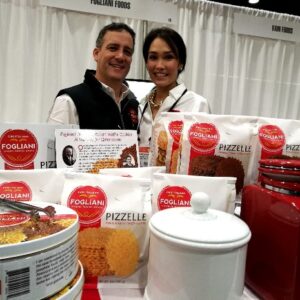
We bumped into a good example of this at the Winter Fancy Food: Fogliani, a Californian company with an Abruzzo’s heart and the Italian claim: “vivere, ridere, amare” – live, laugh, love. Christian Fogliani and his wife Kristina are the owners and managers of the company that produces sweets following the family recipes. Fogliani’s forte are the pizzelle, that, to explain to all people that are not from Abruzzo, are cookies like the Belgian waffles that you can find everywhere from the Adriatic see to the Gran Sasso, so much so that every family in Abruzzo used to have a stamp with the family initials.
“My grandfather arrived in the United States in 1904 from Abruzzo and started his first pasta factory and then a cookie factory. I was a lawyer until one day, a couple of years ago, I decided I wanted to do something that was more meaningful to me and I decided to go back to the cookies. Pizzelle are our own new idea that we came up with from an old recipe that belonged to my grandma. The most exciting thing is that there are people that still remember their grandma or aunt making these cookies.” Italians emigrate, generations pass, but recipes stay.












